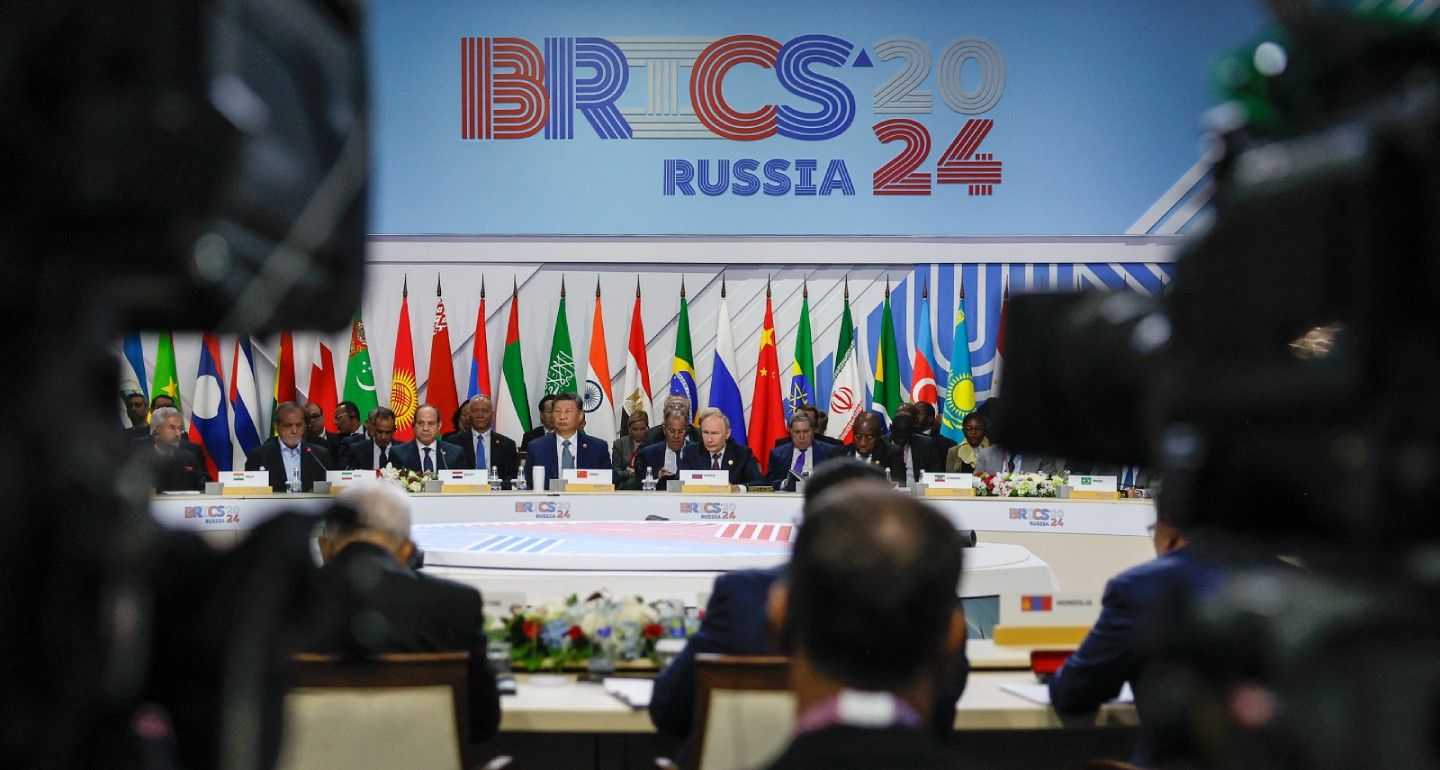It’s easy to dismiss BRICS. The dominant view in the U.S. is that the grouping of emerging economies can’t present a real challenge to the current order – especially when it comes to the global financial system still underpinned by the U.S. dollar. But this week’s BRICS summit hosted by Russian President Vladimir Putin points to a problem. Some of the most impactful countries in the Global South are cozying up to America’s adversaries like China and Russia, hoping to get more maneuvering space amid waning U.S. preeminence. They share an interest in reducing their dependency on the greenback, and have embarked on a long-term project to create hedging options. Whoever wins the U.S. election should pay attention and address the challenge.
When the four emerging markets originally referred to by the acronym—Brazil, Russia, India, and China—held their first summit in Russia in 2009 and established themselves as a political club akin to the G7, their agenda was shaped by the global recession and therefore mostly focused on the redistribution of voting rights in the IMF and World Bank in favor of the developing world. Later the group added South Africa, and last year BRICS expanded to include the UAE, Egypt, Ethiopia, Iran and Saudi Arabia, the latter of which has yet to decide whether to join. But adding more letters doesn’t make the BRICS more functional.
At first glance, the outcomes of the BRICS summit in the Russian city of Kazan that concluded on October 24 support this view. If it’s meant to be the non-Western answer to the U.S.-led G7, the BRICS members are remarkably short on actions they are willing to undertake together. While G7 declarations are usually dotted with hefty financial commitments for joint causes, the 43-page Kazan document largely consists of rounded formulas intended to disguise underlining tensions among BRICS members rather than elaborating an emerging consensus. There were also notable dropouts among participants, including Brazilian president Lula and Saudi Arabia’s Crown Prince Mohammad bin Salman, who opted instead to attend a summit with EU leaders in Brussels.
Finally, the gathering didn’t solve the Kremlin’s task of securing help from its BRICS friends to create alternative channels of funding for its war economy. Even the New Development Bank much touted as a BRICS alternative to the World Bank isn’t financing projects in Russia following Putin’s invasion of Ukraine: the bank trades its bonds on global markets and cannot afford to be cut off from the financial system underpinned by the U.S. dollar.
Still, these setbacks shouldn’t lead to complacency about the more fundamental challenges posed by the rise of BRICS. First, the sheer fact that so many world leaders, including Narendra Modi, leader of the world’s largest democracy India, and the president of NATO-member Turkey, Recep Erdogan, chose to be in Kazan with Putin, shows that Russia’s leader is not the global pariah the West would like to believe he is. More important than photo ops is the fact that trade with the countries attending has provided Putin with a lifeline, despite the sanctions unleashed by the West following the invasion of Ukraine. Moscow’s ability to finance its war, obtain Western technology, and survive strangled access to the dollar and euro points to the limitations of the Western sanctions toolkit and lack of support globally for U.S. policy goals that provide its adversaries with abundant maneuvering space.
Even more consequential will be the conclusions that countries around the world draw from these dynamics. As financial sanctions become America’s geoeconomic weapon of choice and the U.S. fiscal situation continues to erode, with gaping budget deficits and mounting public debt, many countries around the world have legitimate reasons to be worried about their dependency on the U.S. dollar in the long run. For now, there is no credible alternative to the greenback as the world’s only reserve currency, and none is likely to emerge in the short run. But looking at Russia’s experience, many countries are concluding that the Kremlin has managed to muddle through sanctions because it started to de-dollarize its financial system back in 2014 after the annexation of Crimea. Accordingly, to prepare for possible disruptions, they should start looking for hedging options now.
As a movement of non-Western countries, BRICS provides a perfect platform to do just that. Given how different the countries of the grouping are and the number of tensions between the largest players like China and India, it’s hard to imagine a common solution that would create, for example, a BRICS alternative to SWIFT. Rather, BRICS is emerging as a sandbox for experimentation with various non-USD instruments, including payment systems, cryptocurrencies, digitalized mechanisms for trade in national currencies or through barter, and hubs for commodities trading outside of dollar dominance. This patchwork portfolio of non-dollar solutions will be costlier and more cumbersome than the current system, but could be viewed as a hedge against fiscal and geopolitical risks associated with the U.S. The gradual emergence of an alternative to the U.S. dollar will put the current global system with the greenback’s privileged position under increasing stress.
The challenge may seem insignificant and remote, but doing nothing about it only increases the risks of it materializing some years down the road. For obvious reasons, no systemic solution to the problem exists without addressing the state of public finance in the U.S. Beyond that, the U.S. could work more with BRICS members like India and Brazil that are interested in adapting the current order to make it more inclusive, rather than destroying it. For example, the further redistribution of voting rights inside the IMF and World Bank and expansion of their leadership beyond the current American-European duopoly could be a good symbolic start to boost trust and inclusiveness in the existing system.




